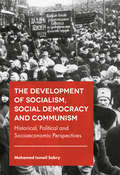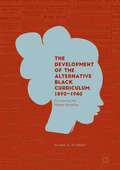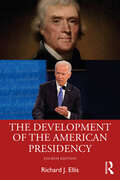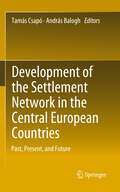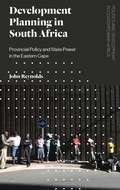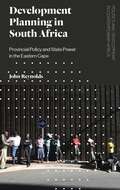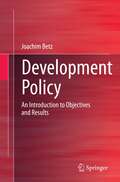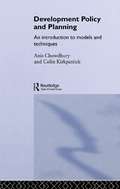- Table View
- List View
The Development of Socialism, Social Democracy and Communism: Historical, Political and Socioeconomic Perspectives
by Dr Mohamed Ismail SabryThis book examines how socioeconomic and institutional factors shaped the development of Socialism and its two contending variants of Social Democracy and Communism, investigating why each of these factions enjoyed varying levels of popularity in different societies between 1840 and 1945. It places a special focus on a number of factors including: inequality; industrialization; urbanization; political freedoms; literacy and education; national sentiments; ethnic fractionalization and other cultural factors. This important study offers a detailed and thorough analysis combining theory, empirical data and a number of important case studies reflecting the different dimensions of Socialism. It offers perspectives on the strength or lack thereof of Social Democracy and Communism during this period across a number of countries, including, Russia, Germany, Sweden, Britain, France, the United States, China, Mexico and many more. The work’s multi-faceted approach provides a rich and thorough analysis of Socialism during this period with new and valuable insights stemming from its unique combination of historic analysis, political theory and institutional economics.
The Development of Socialism, Social Democracy and Communism: Historical, Political and Socioeconomic Perspectives(PDF)
by Mohamed Ismail SabryThis book examines how socioeconomic and institutional factors shaped the development of Socialism and its two contending variants of Social Democracy and Communism, investigating why each of these factions enjoyed varying levels of popularity in different societies between 1840 and 1945. It places a special focus on a number of factors including: inequality; industrialization; urbanization; political freedoms; literacy and education; national sentiments; ethnic fractionalization and other cultural factors. This important study offers a detailed and thorough analysis combining theory, empirical data and a number of important case studies reflecting the different dimensions of Socialism. It offers perspectives on the strength or lack thereof of Social Democracy and Communism during this period across a number of countries, including, Russia, Germany, Sweden, Britain, France, the United States, China, Mexico and many more. The work’s multi-faceted approach provides a rich and thorough analysis of Socialism during this period with new and valuable insights stemming from its unique combination of historic analysis, political theory and institutional economics.
The Development of the Alternative Black Curriculum, 1890–1940: Countering The Master Narrative
by Alana D. MurrayThis book examines black intellectual thought during from 1890-1940, and its relationship to the development of the alternative black curriculum in social studies. Inquiry into the alternative black curriculum is a multi-disciplinary project; it requires an intersectional approach that draws on social studies research, educational history and black history. Exploring the gendered construction of the alternative black curriculum, Murray considers the impact of Carter G. Woodson and W.E.B. DuBois in creating the alternative black curriculum in social studies, and its subsequent relationship to the work of black women in the field and how black women developed the alternative black curriculum in private and public settings.
The Development of the Alternative Black Curriculum, 1890–1940: Countering The Master Narrative (PDF)
by Alana D. MurrayThis book examines black intellectual thought during from 1890-1940, and its relationship to the development of the alternative black curriculum in social studies. Inquiry into the alternative black curriculum is a multi-disciplinary project; it requires an intersectional approach that draws on social studies research, educational history and black history. Exploring the gendered construction of the alternative black curriculum, Murray considers the impact of Carter G. Woodson and W.E.B. DuBois in creating the alternative black curriculum in social studies, and its subsequent relationship to the work of black women in the field and how black women developed the alternative black curriculum in private and public settings.
The Development of the American Presidency
by Richard EllisA full understanding of the institution of the American presidency requires us to examine how it developed from the founding to the present. This developmental lens, analyzing how historical turns have shaped the modern institution, allows for a richer, more nuanced understanding. The Development of the American Presidency pays great attention to that historical weight but is organized by the topics and concepts relevant to political science, with the constitutional origins and political development of the presidency its central focus. Through comprehensive and in-depth coverage, Richard J. Ellis looks at how the presidency has evolved in relation to the public, to Congress, to the executive branch, and to the law, showing at every step how different aspects of the presidency have followed distinct trajectories of change. Each chapter promotes active learning, beginning with a narrative account of some illustrative puzzle that brings to life a central concept. A wealth of photos, figures, and tables allow for the visual presentations of concepts.New to the Fourth Edition Explicit and expanded attention to the role of norms in shaping and constraining presidential power, with special focus on Trump’s norm-breaking and Biden’s efforts to shore up norms; Enhanced focus on the prospects for institutional reform, including in the electoral college, presidential relations with Congress, war powers, and the selection of Supreme Court justices; A full reckoning with the Trump presidency and its significance for the future of American democracy, presidential rhetoric, the unilateral executive, and the administrative state; Coverage of the first year of Biden’s presidency, including presidential rhetoric, relations with Congress and the bureaucracy, use of the war powers, and unilateral directives; Comprehensive updating of debates about the removal power, including the Supreme Court cases of Seila Law v. CFPB and Collins v. Yellen; In-depth exploration of the impact of partisan polarization on the legislative presidency and effective governance; Analysis of the 2020 election and its aftermath; Expanded discussion of impeachment to incorporate Trump’s two impeachments; Examination of presidential emergency powers, with special attention to Trump’s border wall declaration; Review of Biden’s and Trump’s impact on the judiciary; Assessment of Biden’s and Trump’s place in political time.
The Development of the American Presidency
by Richard EllisA full understanding of the institution of the American presidency requires us to examine how it developed from the founding to the present. This developmental lens, analyzing how historical turns have shaped the modern institution, allows for a richer, more nuanced understanding. The Development of the American Presidency pays great attention to that historical weight but is organized by the topics and concepts relevant to political science, with the constitutional origins and political development of the presidency its central focus. Through comprehensive and in-depth coverage, Richard J. Ellis looks at how the presidency has evolved in relation to the public, to Congress, to the executive branch, and to the law, showing at every step how different aspects of the presidency have followed distinct trajectories of change. Each chapter promotes active learning, beginning with a narrative account of some illustrative puzzle that brings to life a central concept. A wealth of photos, figures, and tables allow for the visual presentations of concepts.New to the Fourth Edition Explicit and expanded attention to the role of norms in shaping and constraining presidential power, with special focus on Trump’s norm-breaking and Biden’s efforts to shore up norms; Enhanced focus on the prospects for institutional reform, including in the electoral college, presidential relations with Congress, war powers, and the selection of Supreme Court justices; A full reckoning with the Trump presidency and its significance for the future of American democracy, presidential rhetoric, the unilateral executive, and the administrative state; Coverage of the first year of Biden’s presidency, including presidential rhetoric, relations with Congress and the bureaucracy, use of the war powers, and unilateral directives; Comprehensive updating of debates about the removal power, including the Supreme Court cases of Seila Law v. CFPB and Collins v. Yellen; In-depth exploration of the impact of partisan polarization on the legislative presidency and effective governance; Analysis of the 2020 election and its aftermath; Expanded discussion of impeachment to incorporate Trump’s two impeachments; Examination of presidential emergency powers, with special attention to Trump’s border wall declaration; Review of Biden’s and Trump’s impact on the judiciary; Assessment of Biden’s and Trump’s place in political time.
The Development of the American Presidency: The Rhetorical Presidency In Historical Perspective (Political Development Of The American Nation Ser.)
by Richard J. EllisA full understanding of the institution of the American presidency requires us to examine how it developed from the founding to the present. This developmental lens, analyzing how historical turns have shaped the modern institution, allows for a richer, more nuanced understanding. The Development of the American Presidency pays great attention to that historical weight but is organized by the topics and concepts relevant to political science, with the constitutional origins and political development of the presidency its central focus. Through comprehensive and in-depth coverage, Richard Ellis looks at how the presidency has evolved in relation to the public, to Congress, to the executive branch, and to the law, showing at every step how different aspects of the presidency have followed distinct trajectories of change. Each chapter promotes active learning, beginning with a narrative account of some illustrative puzzle that brings to life a central concept. A wealth of photos, figures, and tables allow for the visual presentations of concepts. New to the Third Edition Analysis of the 2016 election, including the role of the Electoral College and implications of Trump’s nomination for the "party decides" thesis; Exploration of Trump’s Twitter presidency and the effectiveness of using social media to bypass the Washington press corps; In-depth coverage of the development of twentieth-century president–press relations, including a new section on broadcasting the presidency that explores the development of the presidential press conference and presidents’ use of radio and television; Study of national security policy in the Obama administration, with a special focus on the targeted killing of American citizens and Obama’s legacy for presidential war powers; Examination of the original understanding and contemporary relevance of impeachment as well as updated discussion of the president’s pardon power; Discussion of recent developments in the legislative and legal realms, including Trump’s first hundred days, the Garland–Gorsuch episode, and abolition of the filibuster for Supreme Court appointments; Preliminary assessment of Trump’s place in historical time.
The Development of the American Presidency
by Richard J. EllisA full understanding of the institution of the American presidency requires us to examine how it developed from the founding to the present. This developmental lens, analyzing how historical turns have shaped the modern institution, allows for a richer, more nuanced understanding. The Development of the American Presidency pays great attention to that historical weight but is organized by the topics and concepts relevant to political science, with the constitutional origins and political development of the presidency its central focus. Through comprehensive and in-depth coverage, Richard Ellis looks at how the presidency has evolved in relation to the public, to Congress, to the executive branch, and to the law, showing at every step how different aspects of the presidency have followed distinct trajectories of change. Each chapter promotes active learning, beginning with a narrative account of some illustrative puzzle that brings to life a central concept. A wealth of photos, figures, and tables allow for the visual presentations of concepts. New to the Third Edition Analysis of the 2016 election, including the role of the Electoral College and implications of Trump’s nomination for the "party decides" thesis; Exploration of Trump’s Twitter presidency and the effectiveness of using social media to bypass the Washington press corps; In-depth coverage of the development of twentieth-century president–press relations, including a new section on broadcasting the presidency that explores the development of the presidential press conference and presidents’ use of radio and television; Study of national security policy in the Obama administration, with a special focus on the targeted killing of American citizens and Obama’s legacy for presidential war powers; Examination of the original understanding and contemporary relevance of impeachment as well as updated discussion of the president’s pardon power; Discussion of recent developments in the legislative and legal realms, including Trump’s first hundred days, the Garland–Gorsuch episode, and abolition of the filibuster for Supreme Court appointments; Preliminary assessment of Trump’s place in historical time.
The Development of the American Presidency: The Rhetorical Presidency In Historical Perspective (Political Development Of The American Nation Ser.)
by Richard J. EllisA full understanding of the institution of the American presidency requires us to examine how it developed from the founding to the present. This developmental lens, analyzing how historical turns have shaped the modern institution, allows for a richer, more nuanced understanding beyond the current newspaper headlines. The Development of the American Presidency pays great attention to that historical weight but is organized by the topics and concepts relevant to political science, with the constitutional origins and political development of the presidency its central focus. Through comprehensive and in-depth coverage, this text looks at how the presidency has evolved in relation to the public, to Congress, to the Executive branch, and to the law, showing at every step how different aspects of the presidency have followed distinct trajectories of change. All the while, Ellis illustrates the institutional relationships and tensions through stories about particular individuals and specific political conflicts. Ellis's own classroom pedagogy of promoting active learning and critical thinking is well reflected in these pages. Each chapter begins with a narrative account of some illustrative puzzle that brings to life a central concept. A wealth of photos, figures, and tables allow for the visual presentations of concepts. A companion website not only acts as a further resources base—directing students to primary documents, newspapers, and data sources—but also presents interactive timelines and practice quizzes to help students master the book's lessons. The second edition a new chapter on unilateral powers that brings greater attention to domestic policymaking.
The Development of the American Presidency
by Richard J. EllisA full understanding of the institution of the American presidency requires us to examine how it developed from the founding to the present. This developmental lens, analyzing how historical turns have shaped the modern institution, allows for a richer, more nuanced understanding beyond the current newspaper headlines. The Development of the American Presidency pays great attention to that historical weight but is organized by the topics and concepts relevant to political science, with the constitutional origins and political development of the presidency its central focus. Through comprehensive and in-depth coverage, this text looks at how the presidency has evolved in relation to the public, to Congress, to the Executive branch, and to the law, showing at every step how different aspects of the presidency have followed distinct trajectories of change. All the while, Ellis illustrates the institutional relationships and tensions through stories about particular individuals and specific political conflicts. Ellis's own classroom pedagogy of promoting active learning and critical thinking is well reflected in these pages. Each chapter begins with a narrative account of some illustrative puzzle that brings to life a central concept. A wealth of photos, figures, and tables allow for the visual presentations of concepts. A companion website not only acts as a further resources base—directing students to primary documents, newspapers, and data sources—but also presents interactive timelines and practice quizzes to help students master the book's lessons. The second edition a new chapter on unilateral powers that brings greater attention to domestic policymaking.
The Development of the EU as a Sea-Policy Actor: Fish, Ships and Navies
by Finn LaursenThe Development of the EU as a Sea-Policy Actor explores the marine and maritime policies of the European Union (EU), including fisheries, maritime transport, marine environment and maritime safety policies. These policies have made the EU an important sea-policy actor internally and externally. The author places the EU's sea-related policies in a historical context and discusses the explanatory power of various political science theories, international relations and regional integration theories in particular. What emerges clearly is that no one theory can explain the observed developments, but that we need to combine theories to get a fuller understanding and explanation of what is also referred to as the Blue Europe. Entrepreneurship and small business management educators, researchers, scholars, university administrators and mentors and advisors to entrepreneurs will glean the latest insights, programming overviews, best practices and contemporary perspectives that have real applications in these fields.
Development of the Idea of Detente: Coming to Terms (St Antony's Series)
by Michael B. FromanSince the early 1950s, there has been agreement in the US concerning the desirability of improving relations with the Soviet Union. Policymakers have often disagreed, however, about how to implement policy and this book looks at the policy of individual administrations.
The Development of the Law of the Sea Convention: The Role of International Courts and Tribunals
by Øystein JensenThe UN Convention on the Law of the Sea (UNCLOS) entered into force in November 1994. This insightful book offers in-depth appraisals of the contributions of jurisprudence to this major achievement of international law, tracing the impact that courts and tribunals have had on the development and clarification of various provisions of UNCLOS over the past quarter-century. Exploring the most pressing issues and recent developments concerning the oceans, leading authors discuss the influence of jurisprudence in fields ranging from fisheries to navigation and deep seabed mining, paying particular attention to the impact of dispute settlement in the law of the sea. While many questions remain unresolved, the specific case studies in this book show that courts and tribunals have made significant contributions to key legal concepts, as well as filling regulatory gaps left by UNCLOS. This authoritative and timely work will be of great interest to students and scholars working in public international law, and most particularly law of the sea. Its attention to statute will greatly benefit practitioners including judges, counsels and consultants in international litigation, and its practical approach will capture individuals working for relevant international organizations and NGOs.
Development of the Settlement Network in the Central European Countries: Past, Present, and Future
by Tamás Csapó and András BaloghThis volume intends to summarize the most important changes in the Central European countries and their settlement network emphasizing the last 20 years since the collapse of the Iron Curtain.
Development of the Yangtze River Economic Belt in China (Urban Governance Practices in China)
by Xueqing JingThis book focuses on the level of industrial synergy development of the Yangtze River Economic Belt in China. The main contents include: Linkage Development of the Manufacturing and Logistics Industries of the Yangtze River Economic Belt, Cooperative Development of the Information Industry in the Yangtze River Economic Belt, Coordination and Deepening of Agricultural Development in the Yangtze River Economic Belt, Coordinated Development of the Ecological Environment in the Yangtze River Economic Belt, Development of Regional Financial Integration in the Yangtze River Economic Belt, Port Coordinated Development of the Yangtze River Economic Belt, as well as Industrial Division of the Yangtze River Economic Belt.
Development of Welfare States in Europe and America
by Peter FloraThis volume seeks to contribute to an interdisci-plinary, comparative, and historical study of Western welfare states. It attempts to link their historical dynamics and contemporary problems in an international perspective.Building on collaboration between European-and American-based research groups, the editors have coordinated contributions by economists, political scientists, sociologists, and historians. The developments they analyze cover a time span from the initiation of modern national social policies at the end of the nineteenth century to the present.The experiences of all the presently existing Western European systems except Spain and Por-tugal are systematically encompassed, with com-parisons developed selectively with the experi-ences of the United States and Canada. The devel-opment of the social security systems, of public expenditures!and taxation, of public education and educational opportunities, and of income inequal-ity are described, compared, and analyzed for varying groupings of the Western European and North American nations.This volume addresses itself mainly to two audi-ences. The first includes all students of policyproblems of the welfare states who seek to gain a comparative perspective and historical under-standing. A second group may be more interested in the theory and empirical analysis of long-term societal developments. In this context, the growth of the welfare states ranges as a major departure, along with the development of national states and capitalist economies.The welfare state is interpreted as a general phenomenon of modernization, as a product of the increasing differentiation and the growing size of societies on the one hand, and of processes of social and political mobilization on the other. It is an important element of the structural convergence of modern societies � by its mere weight in all countries � and at the same time a source of divergence by the variations within its institutional structure.
Development of Welfare States in Europe and America
by Peter FloraThis volume seeks to contribute to an interdisci-plinary, comparative, and historical study of Western welfare states. It attempts to link their historical dynamics and contemporary problems in an international perspective.Building on collaboration between European-and American-based research groups, the editors have coordinated contributions by economists, political scientists, sociologists, and historians. The developments they analyze cover a time span from the initiation of modern national social policies at the end of the nineteenth century to the present.The experiences of all the presently existing Western European systems except Spain and Por-tugal are systematically encompassed, with com-parisons developed selectively with the experi-ences of the United States and Canada. The devel-opment of the social security systems, of public expenditures!and taxation, of public education and educational opportunities, and of income inequal-ity are described, compared, and analyzed for varying groupings of the Western European and North American nations.This volume addresses itself mainly to two audi-ences. The first includes all students of policyproblems of the welfare states who seek to gain a comparative perspective and historical under-standing. A second group may be more interested in the theory and empirical analysis of long-term societal developments. In this context, the growth of the welfare states ranges as a major departure, along with the development of national states and capitalist economies.The welfare state is interpreted as a general phenomenon of modernization, as a product of the increasing differentiation and the growing size of societies on the one hand, and of processes of social and political mobilization on the other. It is an important element of the structural convergence of modern societies � by its mere weight in all countries � and at the same time a source of divergence by the variations within its institutional structure.
Development Or Destruction: The Conversion Of Tropical Forest To Pasture In Latin America
by Theodore E. DowningThis book is the outcome of a workshop on the conversion of tropical forest to pasture in Latin America convened in Oaxaca, Mexico in 1988. It examines the dynamics underlying this complex and destructive process and enlisted multiple perspectives in order to identify alternatives.
Development Or Destruction: The Conversion Of Tropical Forest To Pasture In Latin America
by Theodore E. Downing Susanna B. Hecht Henry A. Pearson Carmen Garcia-DowningThis book is the outcome of a workshop on the conversion of tropical forest to pasture in Latin America convened in Oaxaca, Mexico in 1988. It examines the dynamics underlying this complex and destructive process and enlisted multiple perspectives in order to identify alternatives.
Development Paradigms for Urban Housing in BRICS Countries
by Piyush Tiwari Jyoti Rao Jennifer DayThis book is a concise treatise of the alternative paradigms used in BRICS countries to tackle urban housing shortages. There are a number of alternative methods for meeting these shortages which BRICS countries have adopted. These alternatives may agree in terms of desired outcome, but when it comes to approach, mechanics and scope, they are entirely divergent. By focusing on the political economy and the international structure of each BRICS country, these perspectives present alternative and often conflicting approaches to the attainment of better housing.Development Paradigms for Urban Housing in BRICS Countries explores the various political, economic, institutional and cultural factors that have shaped the housing outcomes in BRICS countries that we see today. The book uses a framework which allows comparison between Brazil, Russia, India, China and South Africa, whilst recognizing the differences in the development path that each of these countries has taken.
Development Planning in South Africa: Provincial Policy and State Power in the Eastern Cape (Politics and Development in Contemporary Africa)
by John ReynoldsCelebrated as a beacon of democracy and reconciliation, many people in South Africa continue to live in severe poverty, particularly in the Eastern Cape Province. Backed by the United Nations Development Programme, the Eastern Cape's provincial government consequently launched an historically ambitious programme – the Provincial Growth and Development Plan – aimed at tackling the province's poverty, unemployment and inequality over a ten-year period in a radical policy overhaul.Drawing on the author's first-hand engagement with the planning process, Development Planning in South Africa is an empirically rich study that utilises a strategic-relational approach to explore the ways in which this unprecedented challenge was negotiated and eventually undermined by the South African state.The first work of its kind, the book provides an indispensable micro-level study with profound implications for how state power is understood to be organised and expressed in state policy. Relevant beyond South Africa to policy implementation in both developing and developed states globally, the book is essential reading for students and scholars of government studies, political economy, development, policy studies and social movements.
Development Planning in South Africa: Provincial Policy and State Power in the Eastern Cape (Politics and Development in Contemporary Africa)
by John ReynoldsCelebrated as a beacon of democracy and reconciliation, many people in South Africa continue to live in severe poverty, particularly in the Eastern Cape Province. Backed by the United Nations Development Programme, the Eastern Cape's provincial government consequently launched an historically ambitious programme – the Provincial Growth and Development Plan – aimed at tackling the province's poverty, unemployment and inequality over a ten-year period in a radical policy overhaul.Drawing on the author's first-hand engagement with the planning process, Development Planning in South Africa is an empirically rich study that utilises a strategic-relational approach to explore the ways in which this unprecedented challenge was negotiated and eventually undermined by the South African state.The first work of its kind, the book provides an indispensable micro-level study with profound implications for how state power is understood to be organised and expressed in state policy. Relevant beyond South Africa to policy implementation in both developing and developed states globally, the book is essential reading for students and scholars of government studies, political economy, development, policy studies and social movements.
Development Policy: An Introduction to Objectives and Results
by Joachim BetzDeveloping countries have made rapid but highly varied progress since the 1990s. So much so that the boundaries to the traditional industrialized countries have become partially blurred. On the other hand, there are a number of mostly fragile states that have not succeeded in doing so, or have only rudimentarily succeeded. Talk of one "Third World" and common development problems thus explains little. Instead, development has become a requirement for all states, which this textbook breaks down and assesses according to key development goals.This book is a translation of the original German 1st edition Entwicklungspolitik by Joachim Betz, published by Springer Fachmedien Wiesbaden GmbH, part of Springer Nature in 2021. The translation was done with the help of artificial intelligence (machine translation by the service DeepL.com). A subsequent human revision was done primarily in terms of content, so that the book will read stylistically differently from a conventional translation. Springer Nature works continuously to further the development of tools for the production of books and on the related technologies to support the authors.
Development Policy and Planning: An Introduction to Models and Techniques
by Anis Chowdhury Colin KirkpatrickReorientation from economic controls to a market-based approach led to significant changes in the economic policy of developing countries in the 1980s. Yet, with governments continuing to exercise economic management to accelerate growth beyond that achieved by market forces, techniques and models of development planning are still an integral feature of development policy management. Development Policy and Planning provides a non-technical explanation of the main techniques and models used for economic policy formulation. Each technique is illustrated in application through practical examples.
Development Policy and Planning: An Introduction to Models and Techniques
by Anis Chowdhury Colin KirkpatrickReorientation from economic controls to a market-based approach led to significant changes in the economic policy of developing countries in the 1980s. Yet, with governments continuing to exercise economic management to accelerate growth beyond that achieved by market forces, techniques and models of development planning are still an integral feature of development policy management. Development Policy and Planning provides a non-technical explanation of the main techniques and models used for economic policy formulation. Each technique is illustrated in application through practical examples.
